Infant Car Seat Safety Features: A Full Guide
Safety first! Learn how infant car seats keep your little one safe and sound.

Mommyhood101 independently tests and curates baby gear to help you make informed decisions. If you buy products through links on our site, we may earn a commission.
An infant car seat will get your little one safely home from the hospital and keep them safe on the road for years to come.
Rest assured, all infant car seats sold in the U.S. meet federal safety standards.
However, infant car seat safety features vary tremendously between models and can influence the car seat's performance during an accident.
In this guide, we cover the most important safety features to look for in an infant car seat to give you peace of mind that your little one is not only comfortable and happy, but also safe and sound during trips across town or across the country.
The Basics of Infant Car Seat Safety
All infant car seats are rear-facing for maximum protection of your child's musculoskeletal system during the event of an accident.
Rear-Facing as Long as Possible!
Most modern infant car seats will allow your little one to rear face until they are 35 pounds. Some others, like the Maxi Cosi Mico and Cybex Aton, have lower weight limits.
Most toddlers will reach the car seat's height limit before they reach the weight limit.
Infant car seats typically have a height limit of 32", but it varies by manufacturer and model. For example, the Cybex Aton 2 only supports up to 30" tall, whereas the Chicco Fit2 35 supports up to 35" tall.
Because rear-facing is the safest way to ride, we strongly recommend finding a car seat with a high weight limit (35 pounds), and a high height limit (30").
Here are some of the best infant car seats and their weight and height limits:
| Car Seat Make & Model | Weight Limit (lbs) | Height Limit (inches) |
| Chicco KeyFit 35 | 35 lbs | 32" |
| Britax B-Safe Gen2 | 35lbs | 32" |
| UPPAbaby Mesa V2 | 35 lbs | 32" |
| Graco Snugride 35 | 35 lbs | 32" |
| Doona Car Seat | 35 lbs | 32" |
| Nuna Pipa | 32 lbs | 32" |
| Chicco Fit2 35 | 35 lbs | 35" |
| Maxi-Cosi Mico Max | 30 lbs | 32" |
| Clek Liing | 35 lbs | 32" |
| Cybex Aton 2 | 32 lbs | 30" |
| Peg Perego Primo Viaggio | 35 lbs | 32" |
For maximum safety, keep your child rear-facing for as long as possible. How long is possible? It depends on the car seat, so follow the manufacturer's instructions.
Given its 35-pound weight limit and extended height limit (35"), we think the Chicco Fit2 35 supports rear-facing for the longest of any infant car seat on the market.
Once your child has grown out of their infant car seat in height or weight, they are ready to transition to a convertible car seat. These car seats can also be installed in the rear-facing position, and in some cases, they can support children up to 50 pounds and about 43" tall in the rear-facing position!
As recommended by the AAP car seat safety guide, do not transition your child to front-facing until they reach the highest weight or height allowed by the car seat manufacturer.
Harnesses and Adjustments
All infant car seats sold in the United States will come equipped with a five-point safety harness. This means that the car seat has two shoulder belts and a lower buckle, attaching to the car seat at five points (right and left shoulders, right and left hips, and bottom center between the legs).
For maximum safety, be sure to follow the manufacturer's guidance regarding harness height, chest buckle height, and crotch buckle position.
Harness height: Ensure that the shoulder harness height is positioned such that the slots are at or below the height of your child's shoulders. This applies only to the rear-facing position.
Here is a photo of what the shoulder harness height should look like:
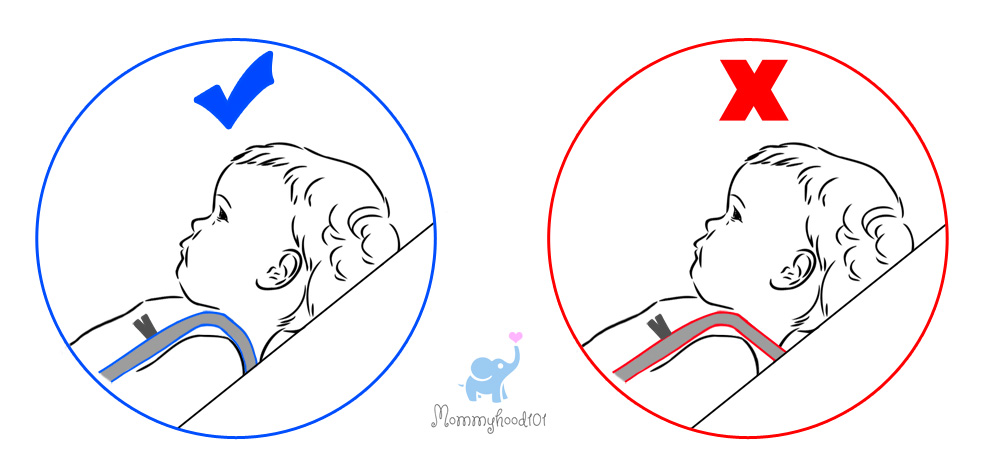
Chest clip height: Ensure that the chest clip is positioned at the same level as your child's armpits.
Here is a photo of what the chest clip height should look like:
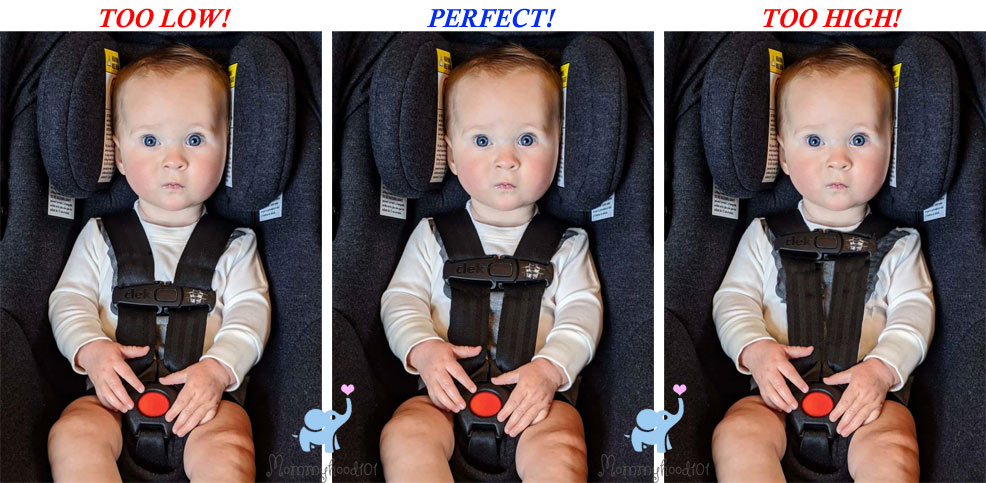
Proper Installation is Critical!
Follow the manufacturer's instructions meticulously to ensure the correct installation and usage of the car seat.
The proper installation of an infant car seat is absolutely critical for ensuring the safety of the child during car rides.
Numerous examples highlight the potential dangers that arise from improper installation.
For example, if the seat is not securely fastened to the vehicle, it may shift or become dislodged during sudden stops or collisions, putting the infant at risk of severe injuries.
Incorrect positioning of the harness straps can lead to the child slipping out of the seat or being improperly restrained, increasing the likelihood of injury in the event of an accident.
Furthermore, failure to properly adjust the recline angle of the car seat to fit the infant's size and age can result in the child's head flopping forward, potentially obstructing their airway and causing breathing difficulties.
Thus, it is crucial to follow the manufacturer's guidelines meticulously and seek professional assistance (from your local police or fire department, or find a certified CPST technician) if needed to ensure the proper installation of an infant car seat, prioritizing the safety and well-being of the child.
Steel-Reinforced Frame
A steel-reinforced frame in an infant car seat refers to the presence of a sturdy steel structure within the seat's or base's construction.
This reinforcement enhances the overall strength and integrity of the car seat, providing robust protection for the child.
The steel-reinforced frame is important for infant safety as it offers superior durability and impact resistance during collisions, minimizing the risk of the seat collapsing or deforming under the force of an accident, thereby reducing the potential for severe injuries.
Very few infant car seats incorporate steel-reinforced frames in their designs, but some notable examples include the Chicco KeyFit 30 and the Britax B-Safe Gen2. For the Britax, the steel reinforcement is in the base, so it will not weigh down the seat itself.
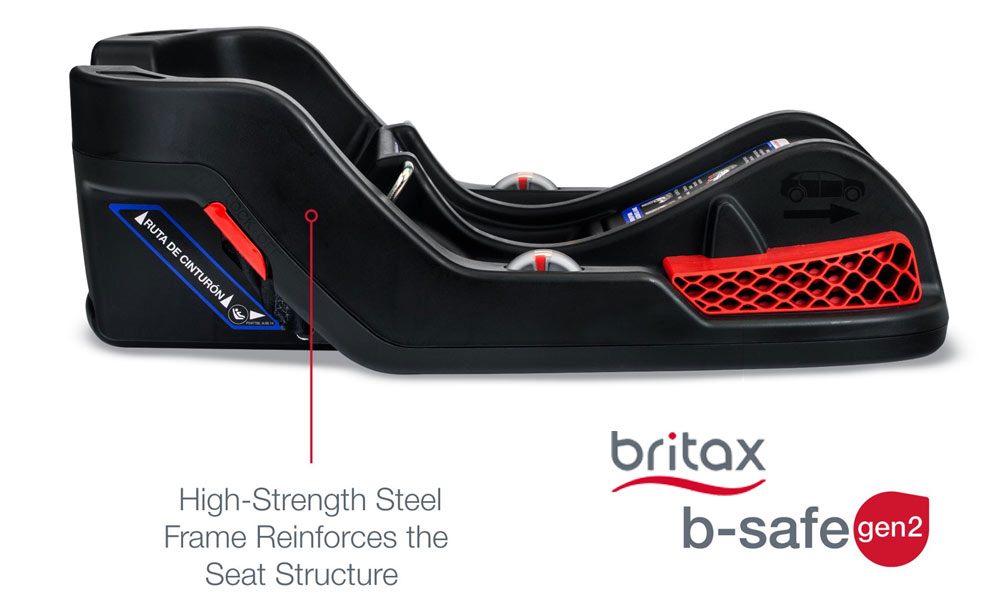
Speaking of which, the only downside of a steel-reinforced frame incorporated into the car seat itself is that it makes the infant car seat considerably heavier. In most cases, the steel reinforcement will add at least 2-4 pounds to the car seat.
Personally, we think it's worth the peace of mind, and who doesn't appreciate the toned biceps that will result!?
Side-Impact Protection
Side impact protection in an infant car seat refers to the specialized features and design elements incorporated to mitigate the impact forces experienced during a side collision.
It is a critical aspect of infant safety as side impact "t-bone" crashes can pose significant risks to a child's vulnerable head, neck, and torso. In fact, they are the second leading cause of injury for children riding in car seats.
Side impact protection typically includes energy-absorbing materials, such as EPS or EPP foam and/or air cushions, strategically placed within the seat's shell to absorb and dissipate the crash forces away from the infant.
Additionally, car seats may employ reinforced sidewalls or adjustable headrests with deep side wings to provide enhanced support and containment, minimizing the potential for head and torso movement during a side impact.
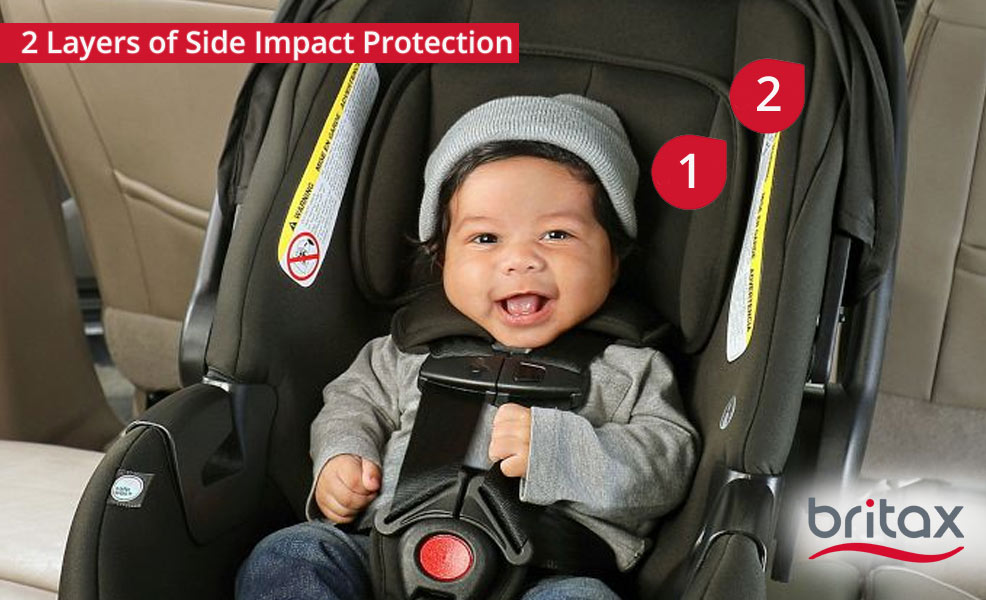
Another recent development is the side impact protection pod, which is a small piece of plastic that protrudes from each side of some car seats. This pod reduces the distance between the car seat and the vehicle's door, reducing forces experienced by a child during a side collision. A good example is the Nuna SIP system, which is included in the popular Nuna RAVA convertible car seat.
Other innovative side impact protection systems, such as the use of advanced airbag technologies, have also emerged in recent years. These systems deploy upon impact, creating an additional protective barrier to shield the child from the lateral crash forces. One example is in the Maxi-Cosi AxissFix Air convertible car seat, though it is not available in the United States.
In general, brands like Britax, Maxi-Cosi, and Graco are known for their incorporation of innovative side impact protection systems in their infant car seat models, emphasizing the utmost safety and protection for infants in the event of a side collision.
Note that the NHTSA recently established new standards for side impact testing, any car seat intended to support a child under 40 pounds.
This new side impact test includes a 30mph side impact "t-bone" collision. That's good news for anyone purchasing an infant car seat from 2022 and beyond.
Energy-Absorbing Foam
Energy-absorbing foam, including EPS (expanded polystyrene), EPE (expanded polyethylene), and EPP (expanded polypropylene) foam, refers to a specialized material designed to absorb and dissipate impact forces during a collision.
It is strategically incorporated in various areas of a car seat, such as the seat shell, headrest, and side wings.
The primary benefit of energy-absorbing foam is that it helps to reduce the intensity of crash forces transferred to the baby's body, thereby minimizing the risk of injuries. This foam material is engineered to compress and deform upon impact, effectively absorbing and dispersing the energy generated during a crash.

Recent innovations in this area have focused on enhancing the performance of energy-absorbing foam. For instance, manufacturers have developed advanced formulations and structures to improve foam density, durability, and impact resistance. Some car seats now feature multiple layers or zones of energy-absorbing foam to provide optimized protection in specific areas, such as the head and torso.
Additionally, advancements in technology have led to the integration of advanced materials, such as memory foam or specialized polymer blends, that offer superior energy absorption properties. These innovations continuously improve the safety standards of car seats, ensuring enhanced protection for babies in the event of a collision.
Our recommendation is to find a car seat with at least two layers of EPS or EPP energy-absorbing foam, typically marketed as side impact layers for the head and torso.
Crumple Zones
Just like your vehicle has crumple zones that are designed to dissipate energy in the event of a collision, car seats are also beginning to incorporate this technology.
Energy-absorbing crumple zones in infant car seats refer to specific areas or materials strategically placed within the seat to absorb and dissipate impact forces during a collision.
One example of such a material is the SafeCell Impact Protection used by Britax. These crumple zones are typically found in the base of the car seat, where they are designed to deform and collapse upon impact, effectively redirecting crash forces away from the baby.
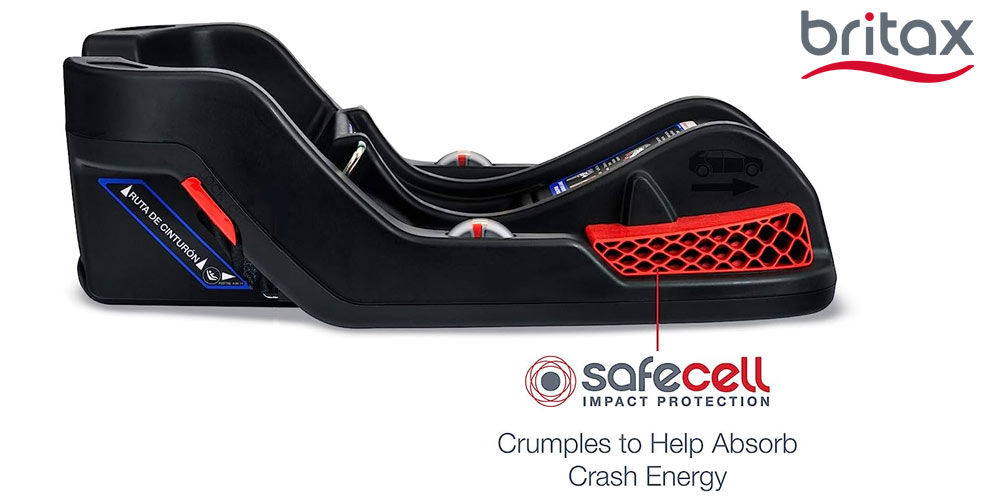
The purpose of these crumple zones is to reduce the intensity of the impact and extend the duration of the collision, thereby reducing the transmitted forces to the infant. By absorbing and dissipating energy, the crumple zones help to minimize the risk of severe injuries to the baby's delicate body, particularly the head and torso.
The SafeCell Impact Protection material, employed by Britax, is specifically engineered to compress and deform during a crash, enhancing the overall safety performance of the car seat.
This innovative feature exemplifies the continuous efforts by manufacturers to prioritize infant safety by incorporating advanced technologies and materials in car seat designs.
Anti-Rebound Protection
Anti-rebound bars and load legs are important safety features found in some modern infant car seats.
An anti-rebound bar is a sturdy metal bar attached to the rear-facing base of the car seat. Its purpose is to limit the backward rotational movement or rebound of the seat during a collision, particularly a rear-end collision.
By preventing excessive motion, the anti-rebound bar helps to protect the baby from potential injuries caused by violent jolts.
A load leg is a support leg that extends from the base of the car seat to the vehicle floor. It serves to stabilize the seat and minimize forward rotation and rebound in the event of a crash.
Both of these features effectively enhance the safety of infants by reducing the potential for excessive movement, particularly during frontal and rear-end collisions.
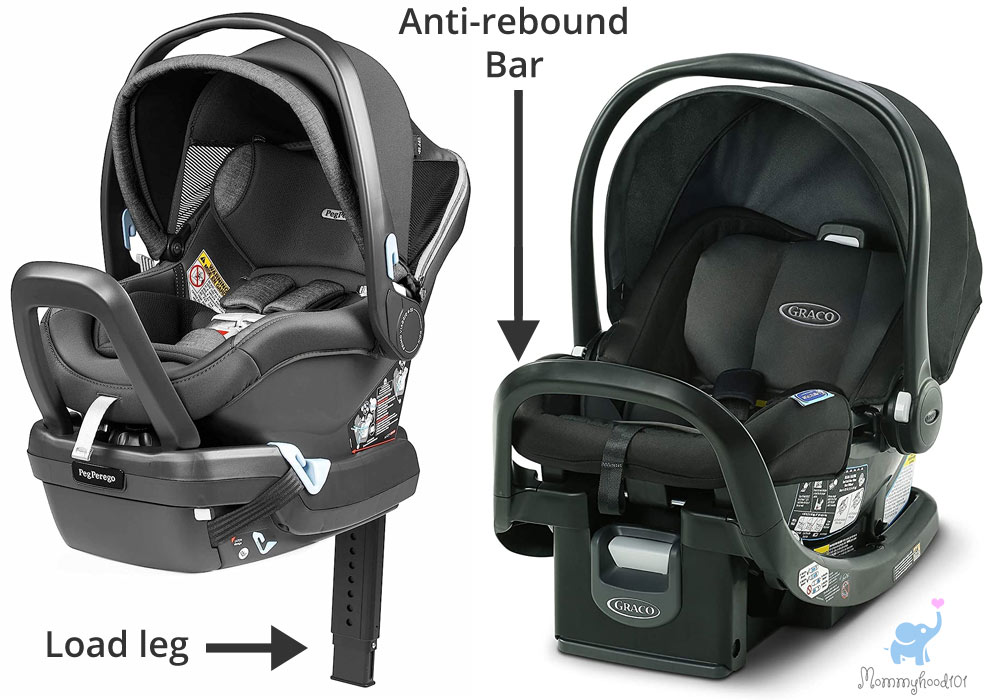
Several infant car seat models incorporate anti-rebound technologies.
For instance, the Chicco KeyFit 35, Graco SnugRide SnugFit 35, Britax B-Safe Gen2 FlexFit+, Clek Liing, and the Peg Perego Primo Viaggio Kinetic all feature anti-rebound bars, while the Cybex Aton M includes a load leg.
There are also a few infant car seats with both an anti-rebound bar and load leg, such as the Peg Perego Primo Viaggio Nido and the Graco SnugRide SnugFit 35 XT. That's the best of both worlds, serving to reduce both forward and backward rotational movement in the event of a rear-end or front-end collision.
Recent innovations in this area have focused on improving the adjustability and ease of use of these features, allowing parents to properly position and secure the anti-rebound bars and load legs in their vehicles.
Easy Installation
Achieving a proper installation of an infant car seat is one of the most important factors for ensuring safety.
Some car seats are much easier to install correctly than others.
You must carefully follow the manufacturer's instructions and guidelines. It is essential to pay attention to details such as fastening instructions, the recline angle of the seat, the positioning of the harness straps, the positioning of the crotch buckle, and the tightness of the installation.
The LATCH system typically makes installation easier and more stable than with the seat belt, but both methods are similarly safe and secure. Never use both the LATCH and vehicle seat belt when installing the car seat base.
If you are interested in installing the car seat without the base, such as when ride sharing, then look for a car seat with the European belt path, such as the Britax B-Safe Gen2 FlexFit.
In general, the easiest car seats to install are the Chicco KeyFit 30 and 35, the Nuna Pipa (with the awesome True Lock system), and the Britax B-Safe Gen2.
If you are uncertain or unfamiliar with the installation process, seeking assistance is highly recommended. The NHTSA has a great video that steps you through car seat installation, and Certified Child Passenger Safety Technicians (CPSTs) can provide expert guidance and ensure that the car seat is installed correctly.
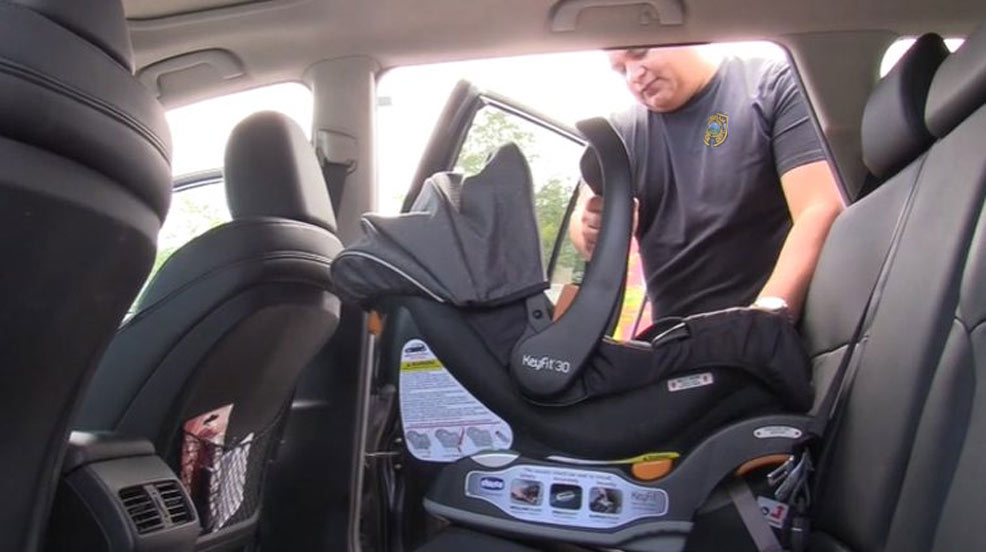
Many local police and fire stations offer free car seat installation checks and assistance.
A properly installed car seat will help prevent the seat from shifting or becoming dislodged during sudden stops or collisions and ensures that the child is securely restrained and positioned, minimizing the risk of severe injuries.
Taking the time to achieve a proper installation is a crucial step in prioritizing the safety and well-being of your child while traveling in a vehicle.
Chemical Emissions
Reducing chemical emissions from car seats is crucial for ensuring a baby's safety, health, and overall well-being.
Infants have developing respiratory systems and heightened sensitivity to environmental factors, making them more vulnerable to the potentially harmful effects of chemical exposure.
Common chemicals and volatile organic compounds (VOCs) used in infant car seat manufacturing include:
- Flame retardants, such as brominated and chlorinated compounds, are often found in fabric and foam. Flame retardants have been associated with adverse health effects, including endocrine disruption and potential neurodevelopmental issues.
- Plastic components in car seats may contain phthalates, which are used to increase flexibility but have been linked to respiratory problems and reproductive disorders.
- Formaldehyde, used in adhesives and finishes, and benzene, found in some foam materials, are known carcinogens.
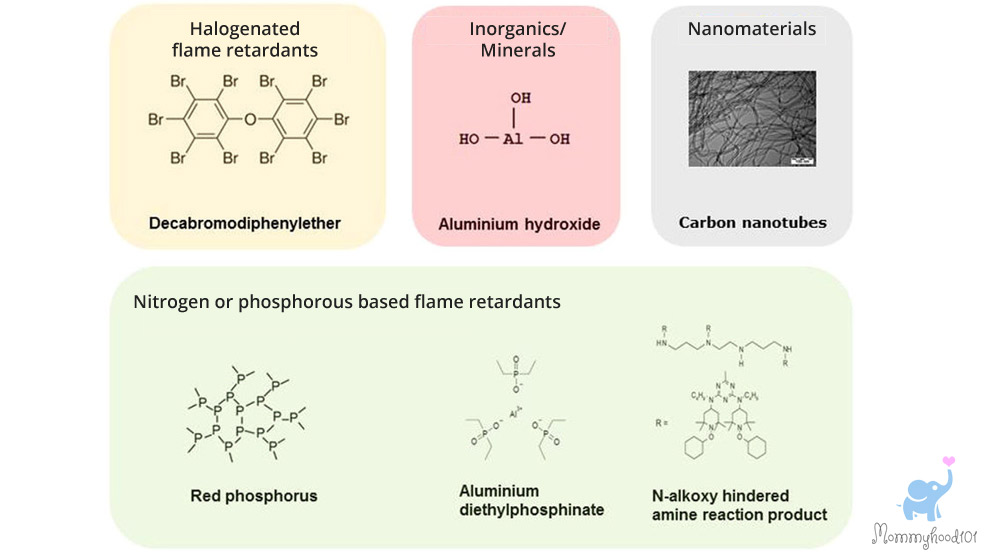
Recognizing and reducing the presence of these chemicals in car seat manufacturing is crucial to protect the health and well-being of infants.
In recent years, there have been notable improvements in reducing chemical emissions from car seats. Manufacturers have started to use alternative materials and production processes that minimize the use of harmful chemicals.
For example, some car seat brands now utilize naturally flame-resistant fabrics (such as wool) or innovative flame retardant alternatives, reducing the need for toxic flame retardants.
Newer foam materials may incorporate soy-based or bio-based foams that have lower VOC emissions compared to traditional petroleum-based foams.
To help consumers make informed choices, certification programs like Greenguard GOLD have been established. These programs evaluate the chemical emissions of products, including car seats, and provide certification for those that meet stringent standards for low emissions.
We recommend choosing a car seat with certifications such as Greenguard GOLD, to give you confidence that you're selecting products with reduced chemical emissions.
Proper Use & Care
Regularly inspect the car seat to ensure that various elements are not worn, dirty, or damaged due to wear and tear or abuse.
Check the harness straps for fraying or signs of weakness, and ensure they are properly adjusted to securely restrain the child.
Clean the car seat following the manufacturer's instructions, typically by using mild detergent and warm water to wipe down the fabric and plastic components.
Avoid using harsh chemicals or bleach that could potentially damage the materials.
Some infant car seats have a removable cover that can be machine washed, but be sure to check the owner's manual.
It's important to let the car seat air dry thoroughly before reassembling and using it again.
In addition to caring for the car seat's physical condition, it's crucial to follow proper usage guidelines.
Never use an expired car seat, as its safety features may no longer be effective. Most car seats expire within 6 to 10 years of their manufacturing date.
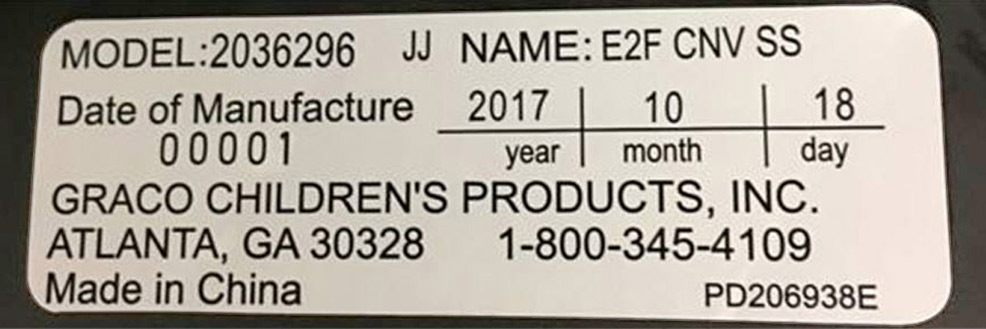
To find the expiration date, check the manufacturer's label or instruction manual. It is typically located on the back or base of the car seat and includes information about the month and year when the seat expires. You can also check out our list of car seat expiration dates here.
Replace the car seat before the expiration date to ensure optimal safety for your child. By properly caring for and using the car seat, parents can ensure its longevity, reliability, and most importantly, the safety of their infant during every car ride.
Conclusions
Understanding the key safety features of infant car seats can help you make an informed decision when it comes time to pick the best infant car seat for your child.
While all car seats sold in the U.S. meet federal safety standards, the safety features can vary significantly between models.
This guide covered the most important safety features to look for in an infant car seat, including rear-facing as long as possible, steel reinforcement, side-impact protection, energy-absorbing foam, crumple zones, rebound protection, easy installation, and considerations for chemical emissions.
By considering these factors and following the manufacturer's instructions meticulously, you can provide your child with a car seat that not only keeps them comfortable but also ensures their safety and well-being on every journey, whether it's a short trip or long-distance travel.
Remember, prioritizing the proper installation and usage of the car seat is critical, and seeking professional assistance if needed is highly recommended. With the right infant car seat and installation, you can have peace of mind knowing that your little one is secure and protected on the road.
References
Car Seat Information Guide from the American Academy of Pediatrics
Find a CPST for Installation Assistance
The NHTSA's New Side-Impact Test Standards for Infant Car Seats
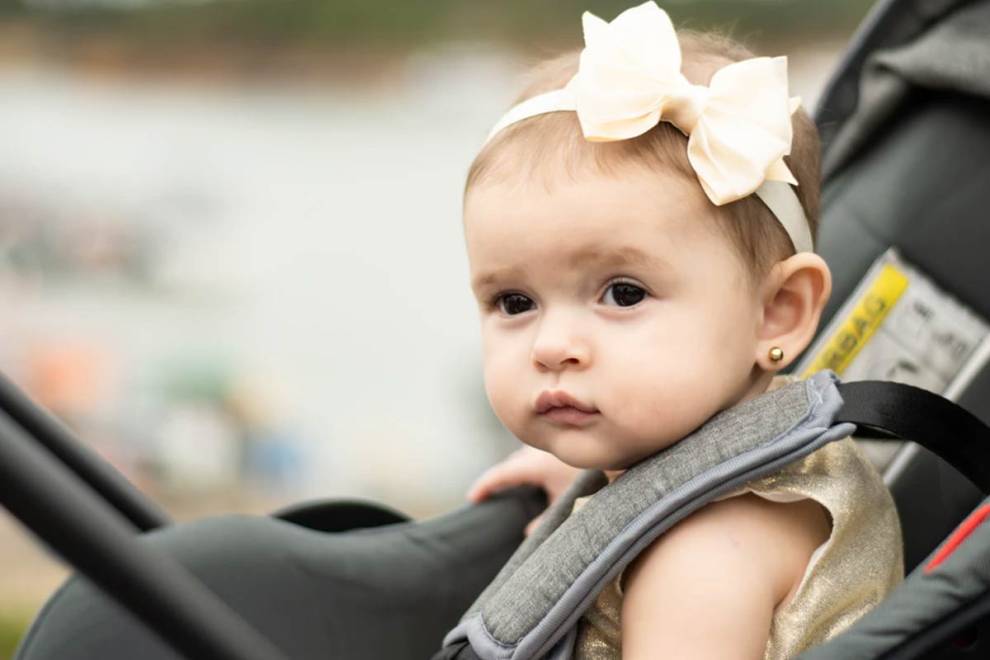
7 Car Seat Mistakes Parents are Making
We've come a long way since the vintage car seats that our parents and grandparents...
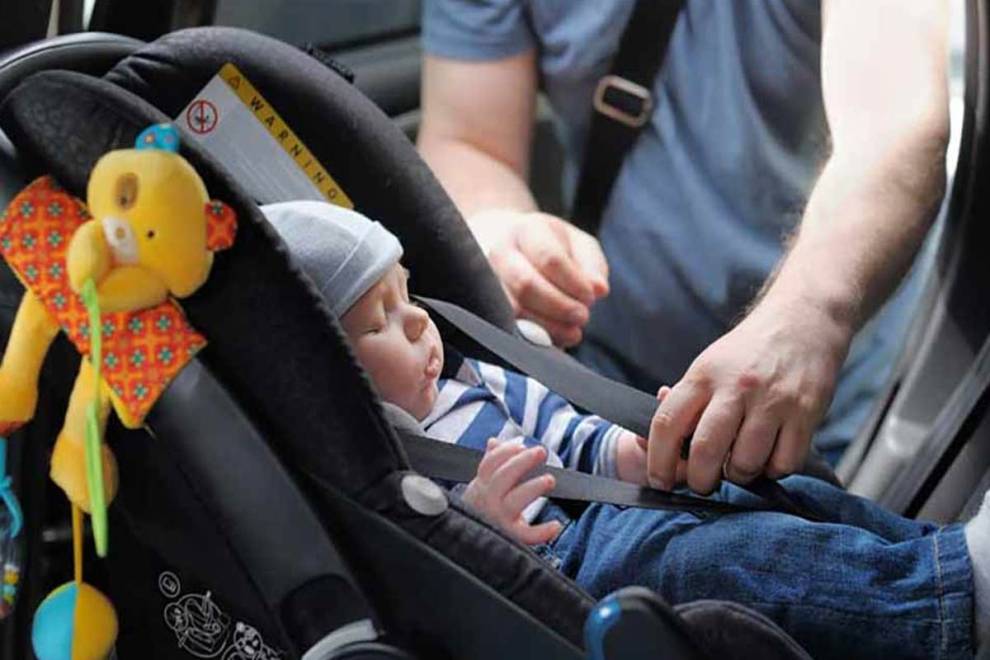
New Recommendations for Rear-Facing Car Seats
The American Academy of Pediatrics (AAP) recently changed their recommendations for how...
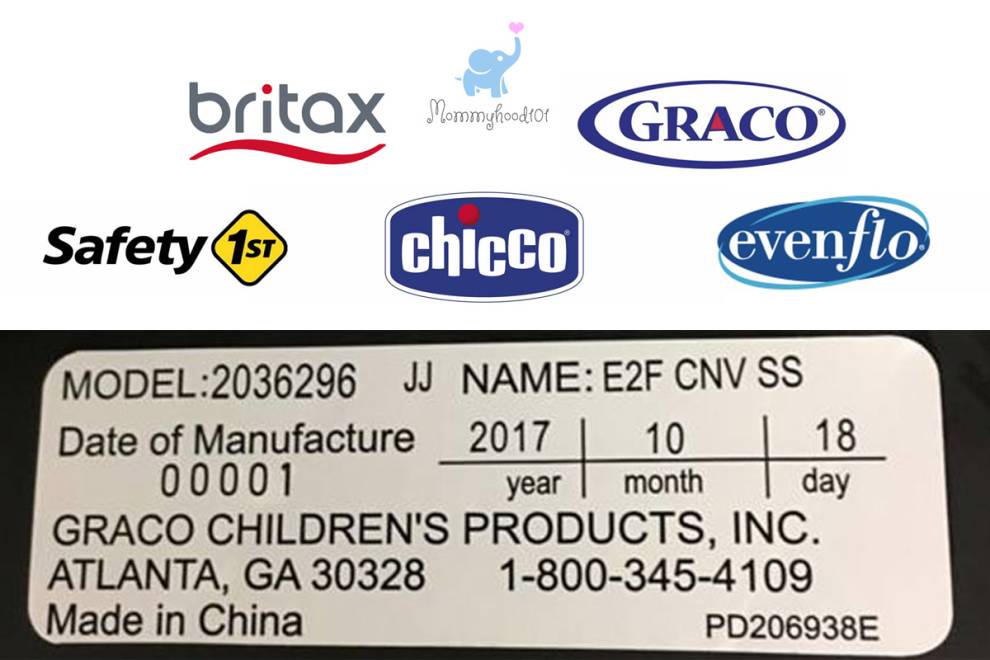
Is your Car Seat Expired? Dates and Guidance
Car seats vary widely in the number of years they can be used after their production...

Baby Jogger City Turn Review & Video
The Baby Jogger City Turn is an awesome example of a rotating car seat, a real...

